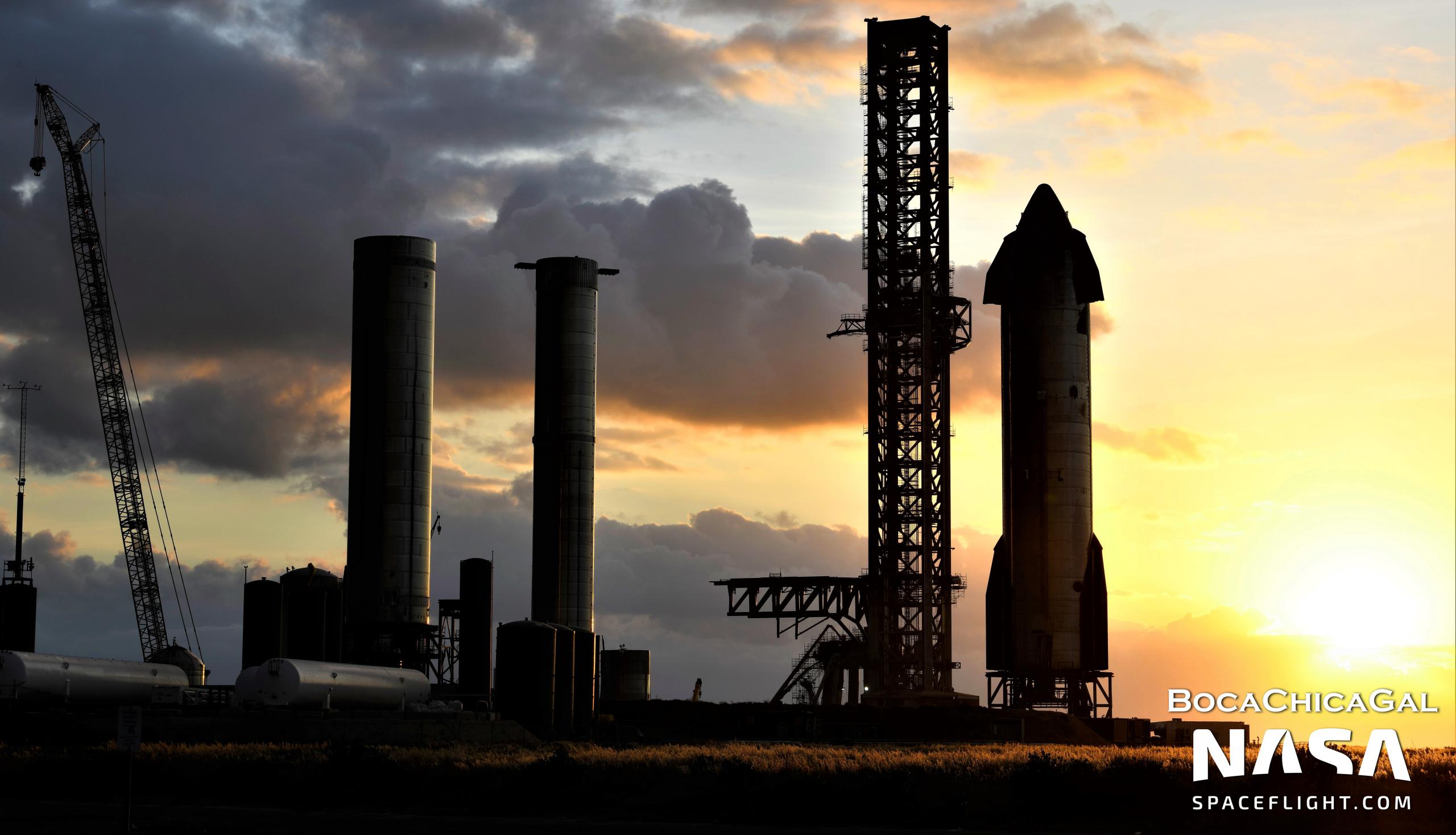
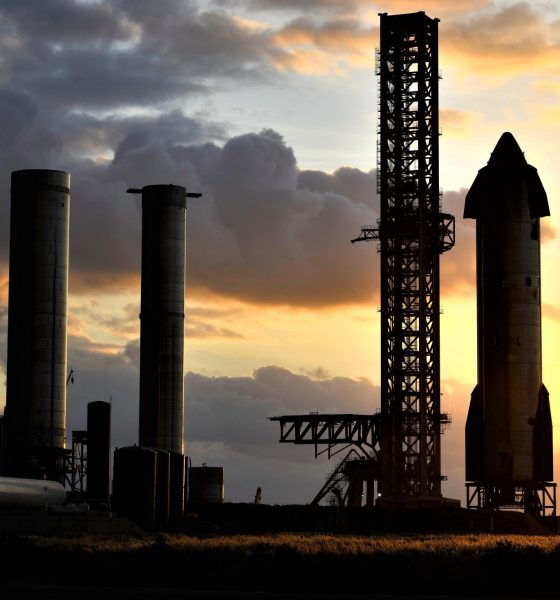
News
SpaceX putting the finishing touches on Starship’s orbital launch pad
SpaceX appears to have begun tying up a number of loose ends at Starship’s first orbital launch site, potentially setting the stage for major rocket testing CEO Elon Musk has stated could begin next month.
The list of tasks started or completed in just the last week or two is significant and each one is singularly focused on similar goals: pave the way for SpaceX to finish testing the first orbital-class Starship and Super Heavy booster and prepare for the first orbital launch attempt of the largest rocket ever built. While SpaceX’s progress towards those goals over the last several months has been decidedly slow relative to the pace of similar work completed in the very recent past, the nominal timeline Musk recently sketched out suggests that things could once again start to happen at a dizzying rate.
Launch Tower
Kicking off a jam-packed two weeks of minor to major finishing touches, SpaceX rigged Starbase orbital launch tower’s rocket-catching arms to a system of pulleys, and ‘drawworks’ in a process known as “reeving.” Thousands of feet of rope were first threaded from up, down, and through the ~145m (~440 ft) tower to act as a temporary guide for the next step. Once fully rigged, anchored, and attached to the start of the steel cable actually meant to operate the system, the tower’s ‘drawworks’ was activated for the first time to reel in the guide rope – simultaneously installing the steel cable. By November 9th, the process was more or less complete, leaving the steel cable firmly attached to the tower’s giant rocket-catching arms and able to carry their significant weight.
Thanks Ralph and @StarshipGazer! Updated diagram below. pic.twitter.com/lUvcbshKGs— LunarCaveman (@LunarCaveman) November 10, 2021
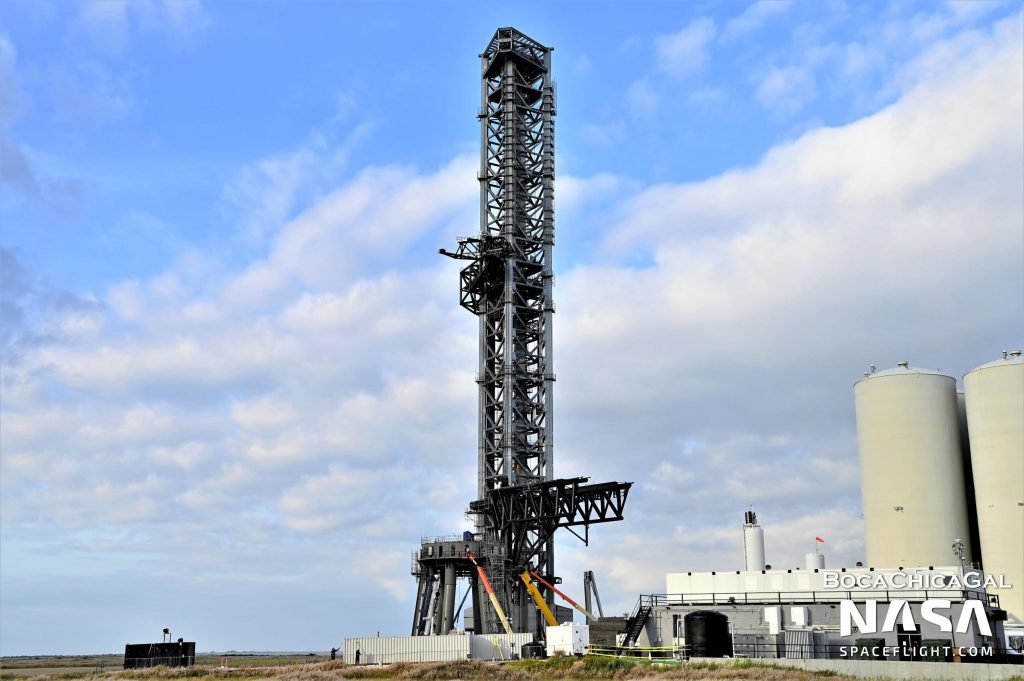
SpaceX hasn’t quite finished installing those arms and does not appear to have picked up the slack in the cable that will eventually lift them up and down the tower, but the arm assembly’s first real move is likely just a few weeks away. Notably, a bit of scaffolding around the tower’s ‘legs’ still needs to be removed before the catch arms can freely roll up and down rails welded to their exteriors. SpaceX will also need to complete shakedown testing of the arms themselves, ensuring that the massive structures’ hydraulic, electrical, and mechanical systems are all working properly.
In the near future, those arms will be used to grab, lift, and install Super Heavy boosters and stack Starships on top of them, while SpaceX also hopes to eventually use them to catch boosters and ships out of mid-air. At least for the former role, a separate arm visible about halfway up the tower in the photo above will also be crucial. Known as the tower’s Starship quick-disconnect (QD) arm or claw, SpaceX has also made significant progress on the structure, practically completing it in the last few days.
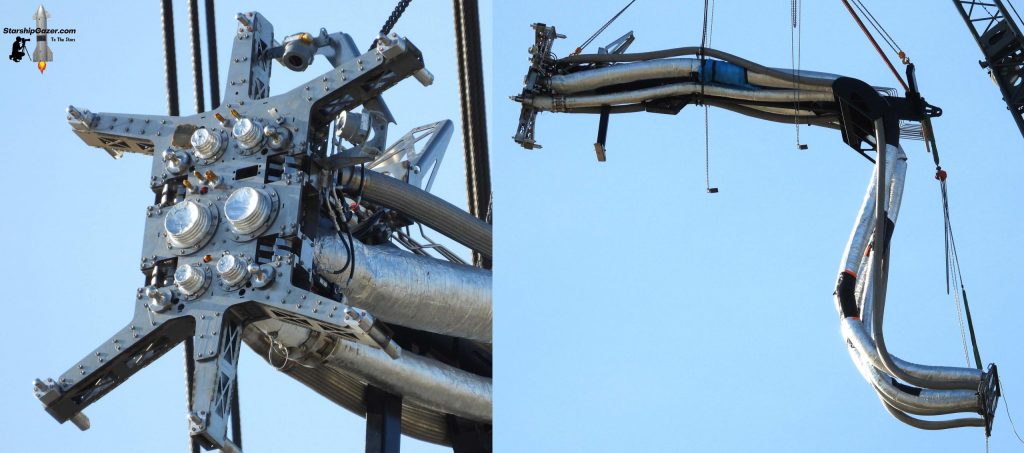
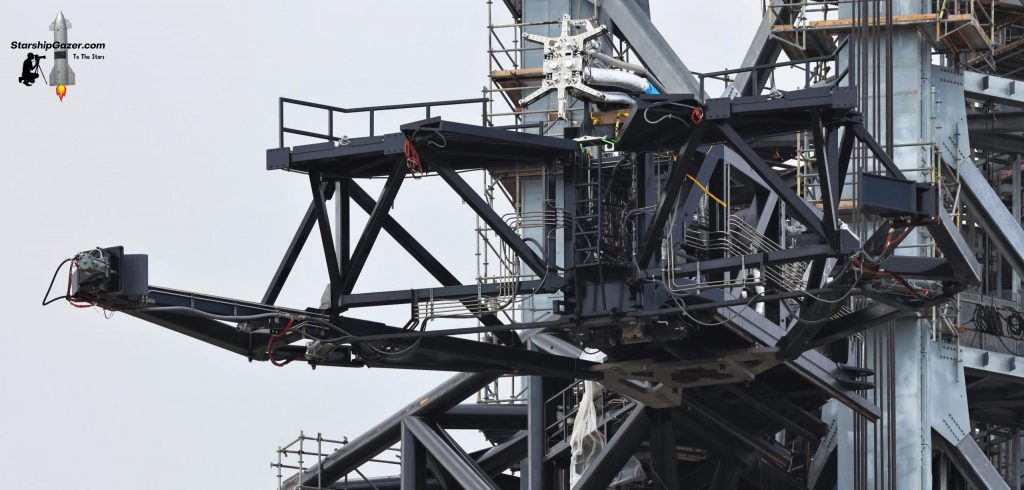
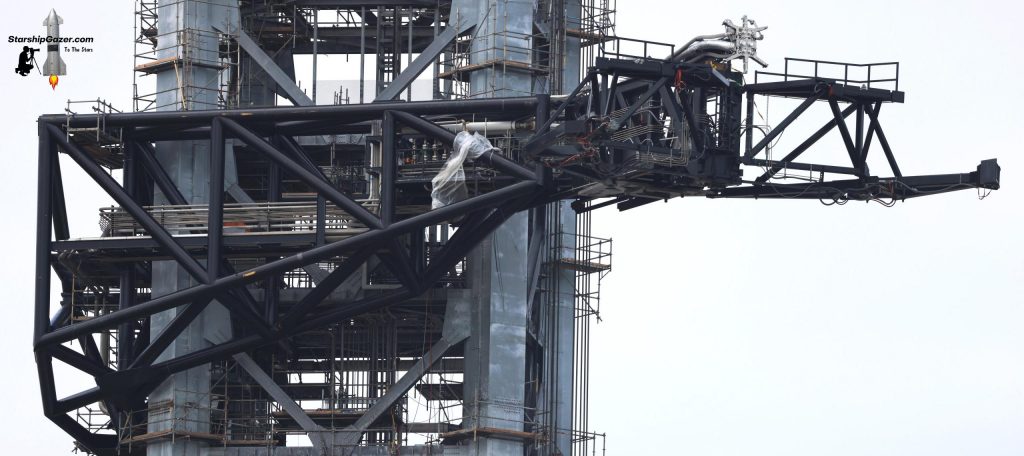
Designed to fuel Starship and stabilize the top of Super Heavy with its claw, the Starship ‘QD arm’ is also able to swing left and right both to quickly back away during launches and to make room for the catch arms during rocket catches and ship/booster stacking operations. Last week, SpaceX technicians finished plumbing the arm, which requires thousands of feet of insulated steel tubes to connect to the pad’s propellant tanks. This week, on November 23rd, SpaceX installed the last major component of the arm – the actual quick disconnect (QD) mechanism that will connect to Starship to supply power, communications, and propellant.
A few small actuators likely still need to be installed and the QD mechanism itself will have to be fully connected to pad systems but the QD arm now appears to be more or less complete and should soon be ready to fuel Starships installed on top of Super Heavy boosters.
Launch Mount
Last but not least, SpaceX performed multiple tests of the pad’s ‘orbital launch mount’ – the giant, steel structure that will support Super Heavy, hold the booster down during testing and before liftoff, and supply it with thousands of tons of propellant. On November 21st, SpaceX completed the first of those tests, seemingly venting an unknown gas out of the mount. More likely than not, it was the first simultaneous test of all 20 of the mounts Raptor Boost engine gas supplies, which – having no need to reignite in flight – will rely on ground gas supplies for ignition. Each of Super Heavy’s 20 outer Raptor engines has a small umbilical and quick disconnect mechanism, resulting in what is likely the most mechanically complex rocket launch mount ever built.
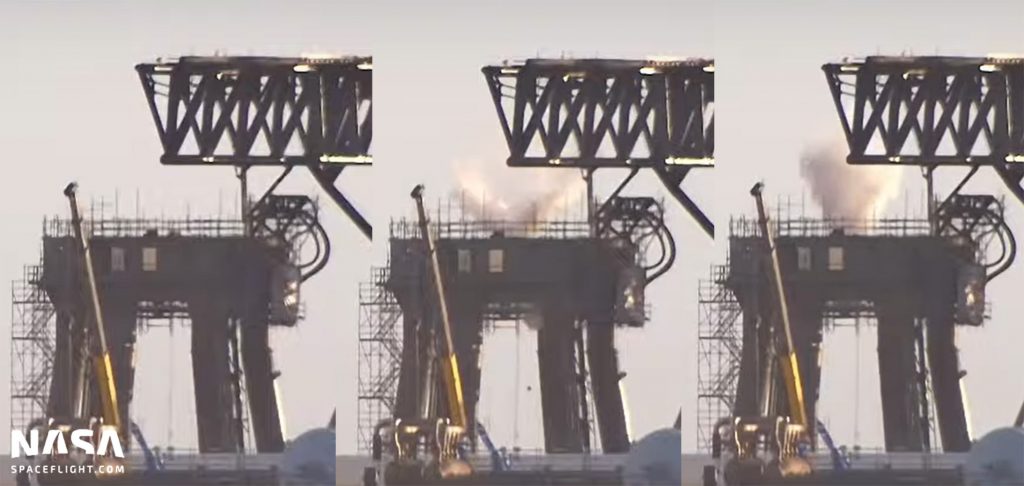
On November 22nd, the orbital launch mount’s booster quick disconnect panel actuated for the first time, showing off the first glimpse of how it will move forward to connect to Super Heavy after a booster is installed on the mount. To prevent its sensitive components from being practically incinerated each launch, the mount’s QD panel will also need to rapidly move away from Super Heavy just before liftoff.
Aside from simply avoiding direct impingement from the several-thousand-degree plume created by 29-33 Raptor engines at full thrust, that movement will also tie into some kind of hood, seamlessly actuating hatches that will close to truly protect the device. That hood was itself spotted for the first time on November 21st and will likely be installed on the launch mount and over the naked QD mechanism in the very near future.
Finally, over the last week or so, SpaceX has begun installing a number of new pipes on and around the launch mount, likely assembling a water deluge system that will help manage the extreme thermal and acoustic environment created by the most powerful rocket in history shortly before and after liftoff. When activated, a spray bar circling the mount’s full interior circumference will likely unleash several tons of water per second in a giant artificial waterfall, hopefully preventing Super Heavy from damaging itself with the sheer sound produced by its Raptor engines or violently eroding the surrounding pad or launch mount legs with its plume.
Ultimately, once all the tower, arm, and mount work described above is completed, the only obvious thing standing between the orbital launch pad and the first Super Heavy booster testing and first orbital Starship launch will be the delivery of liquid methane fuel, which could easily begin any day now.

News
Nvidia CEO Jensen Huang explains difference between Tesla FSD and Alpamayo
“Tesla’s FSD stack is completely world-class,” the Nvidia CEO said.

NVIDIA CEO Jensen Huang has offered high praise for Tesla’s Full Self-Driving (FSD) system during a Q&A at CES 2026, calling it “world-class” and “state-of-the-art” in design, training, and performance.
More importantly, he also shared some insights about the key differences between FSD and Nvidia’s recently announced Alpamayo system.
Jensen Huang’s praise for Tesla FSD
Nvidia made headlines at CES following its announcement of Alpamayo, which uses artificial intelligence to accelerate the development of autonomous driving solutions. Due to its focus on AI, many started speculating that Alpamayo would be a direct rival to FSD. This was somewhat addressed by Elon Musk, who predicted that “they will find that it’s easy to get to 99% and then super hard to solve the long tail of the distribution.”
During his Q&A, Nvidia CEO Jensen Huang was asked about the difference between FSD and Alpamayo. His response was extensive:
“Tesla’s FSD stack is completely world-class. They’ve been working on it for quite some time. It’s world-class not only in the number of miles it’s accumulated, but in the way it’s designed, the way they do training, data collection, curation, synthetic data generation, and all of their simulation technologies.
“Of course, the latest generation is end-to-end Full Self-Driving—meaning it’s one large model trained end to end. And so… Elon’s AD system is, in every way, 100% state-of-the-art. I’m really quite impressed by the technology. I have it, and I drive it in our house, and it works incredibly well,” the Nvidia CEO said.
Nvidia’s platform approach vs Tesla’s integration
Huang also stated that Nvidia’s Alpamayo system was built around a fundamentally different philosophy from Tesla’s. Rather than developing self-driving cars itself, Nvidia supplies the full autonomous technology stack for other companies to use.
“Nvidia doesn’t build self-driving cars. We build the full stack so others can,” Huang said, explaining that Nvidia provides separate systems for training, simulation, and in-vehicle computing, all supported by shared software.
He added that customers can adopt as much or as little of the platform as they need, noting that Nvidia works across the industry, including with Tesla on training systems and companies like Waymo, XPeng, and Nuro on vehicle computing.
“So our system is really quite pervasive because we’re a technology platform provider. That’s the primary difference. There’s no question in our mind that, of the billion cars on the road today, in another 10 years’ time, hundreds of millions of them will have great autonomous capability. This is likely one of the largest, fastest-growing technology industries over the next decade.”
He also emphasized Nvidia’s open approach, saying the company open-sources its models and helps partners train their own systems. “We’re not a self-driving car company. We’re enabling the autonomous industry,” Huang said.
Elon Musk
Elon Musk confirms xAI’s purchase of five 380 MW natural gas turbines
The deal, which was confirmed by Musk on X, highlights xAI’s effort to aggressively scale its operations.

xAI, Elon Musk’s artificial intelligence startup, has purchased five additional 380 MW natural gas turbines from South Korea’s Doosan Enerbility to power its growing supercomputer clusters.
The deal, which was confirmed by Musk on X, highlights xAI’s effort to aggressively scale its operations.
xAI’s turbine deal details
News of xAI’s new turbines was shared on social media platform X, with user @SemiAnalysis_ stating that the turbines were produced by South Korea’s Doosan Enerbility. As noted in an Asian Business Daily report, Doosan Enerbility announced last October that it signed a contract to supply two 380 MW gas turbines for a major U.S. tech company. Doosan later noted in December that it secured an order for three more 380 MW gas turbines.
As per the X user, the gas turbines would power an additional 600,000+ GB200 NVL72 equivalent size cluster. This should make xAI’s facilities among the largest in the world. In a reply, Elon Musk confirmed that xAI did purchase the turbines. “True,” Musk wrote in a post on X.
xAI’s ambitions
Recent reports have indicated that xAI closed an upsized $20 billion Series E funding round, exceeding the initial $15 billion target to fuel rapid infrastructure scaling and AI product development. The funding, as per the AI startup, “will accelerate our world-leading infrastructure buildout, enable the rapid development and deployment of transformative AI products.”
The company also teased the rollout of its upcoming frontier AI model. “Looking ahead, Grok 5 is currently in training, and we are focused on launching innovative new consumer and enterprise products that harness the power of Grok, Colossus, and 𝕏 to transform how we live, work, and play,” xAI wrote in a post on its website.
Elon Musk
Elon Musk’s xAI closes upsized $20B Series E funding round
xAI announced the investment round in a post on its official website.

xAI has closed an upsized $20 billion Series E funding round, exceeding the initial $15 billion target to fuel rapid infrastructure scaling and AI product development.
xAI announced the investment round in a post on its official website.
A $20 billion Series E round
As noted by the artificial intelligence startup in its post, the Series E funding round attracted a diverse group of investors, including Valor Equity Partners, Stepstone Group, Fidelity Management & Research Company, Qatar Investment Authority, MGX, and Baron Capital Group, among others.
Strategic partners NVIDIA and Cisco Investments also continued support for building the world’s largest GPU clusters.
As xAI stated, “This financing will accelerate our world-leading infrastructure buildout, enable the rapid development and deployment of transformative AI products reaching billions of users, and fuel groundbreaking research advancing xAI’s core mission: Understanding the Universe.”
xAI’s core mission
Th Series E funding builds on xAI’s previous rounds, powering Grok advancements and massive compute expansions like the Memphis supercluster. The upsized demand reflects growing recognition of xAI’s potential in frontier AI.
xAI also highlighted several of its breakthroughs in 2025, from the buildout of Colossus I and II, which ended with over 1 million H100 GPU equivalents, and the rollout of the Grok 4 Series, Grok Voice, and Grok Imagine, among others. The company also confirmed that work is already underway to train the flagship large language model’s next iteration, Grok 5.
“Looking ahead, Grok 5 is currently in training, and we are focused on launching innovative new consumer and enterprise products that harness the power of Grok, Colossus, and 𝕏 to transform how we live, work, and play,” xAI wrote.








